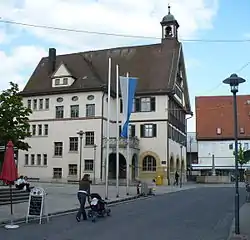Metzingen | |
|---|---|
 Town hall of Metzingen | |
 Coat of arms | |
Location of Metzingen within Reutlingen district  | |
 Metzingen  Metzingen | |
| Coordinates: 48°32′12″N 09°17′09″E / 48.53667°N 9.28583°E | |
| Country | Germany |
| State | Baden-Württemberg |
| Admin. region | Tübingen |
| District | Reutlingen |
| Government | |
| • Lord mayor (2021–29) | Carmen Haberstroh[1] (Ind.) |
| Area | |
| • Total | 34.61 km2 (13.36 sq mi) |
| Elevation | 350 m (1,150 ft) |
| Population (2021-12-31)[2] | |
| • Total | 22,084 |
| • Density | 640/km2 (1,700/sq mi) |
| Time zone | UTC+01:00 (CET) |
| • Summer (DST) | UTC+02:00 (CEST) |
| Postal codes | 72541–72555 |
| Dialling codes | 07123 |
| Vehicle registration | RT |
| Website | www.metzingen.de |

Metzingen (German: [ˈmɛt͡sɪŋən] ⓘ) is a Swabian[3] city with about 22,000 inhabitants, in Reutlingen county, Baden-Württemberg, Germany, 30 km (19 mi) south of Stuttgart.
Geography
The following towns and municipalities are on the borders of Metzingen, they are named starting in the north and belong to district Reutlingen and to district Esslingen: Riederich, Grafenberg, Kohlberg, Neuffen, Dettingen an der Erms, St. Johann, Eningen unter Achalm and Reutlingen.
History
Metzingen was first mentioned in documents from 1075. The cultivation of wine led to a spread of wealth around 1600. From the early 1600s it was under the jurisdiction of Oberamt Urach. During the Thirty Years' War, Metzingen suffered considerable destruction, and two thirds of the population died in a plague epidemic soon after. From the 1800s Metzingen was under the joint jurisdictions of Urach and Schwarzwald county; and finally under the jurisdiction of just Schwarzwald county from the abolition of the Oberamt to the end of World War II, when it was reassigned to the jurisdiction of Reutlingen (district).
Following industrialization, different textile factories were built in Metzingen. In 1859, Metzingen was connected to the railline from Tübingen to Stuttgart.

Neighbourhoods
Since the municipal reform in 1974 the city of Metzingen includes Neuhausen and Glems.
Glems has about 1,000 inhabitants and is located about 5 kilometers from the core city in a side valley of the Erm valley. Until the beginning of 20th century, Glems was predominantly agricultural. As of 2022, Glems still has some full-time farmers who guarantee sustainable landscape management and supply products from regional agriculture. Local shepherds contribute to the preservation of the cultural landscape of the Albtrauf, which are difficult to manage areas. Buildings from the 17th century such as the church, the town hall and the wine press have been preserved. Glems has renovated its town centre since 2000 and has an active village bakery and the Glemser Kelter is a listed building, used as a fruit tree museum, cider farm and community building.[4] The pumped storage plant Glems (Tiefenbachtalsperre or Glemstalsperre) was built in 1962 to supply the region with electricity is located about 1.6 km southwest of the city of Metzingen.[5]
Mayors
|
Politics
The town council has 26 seats, of which the FWV has 9, the GREEN has 6m the CDU has 5, the FDP has 3, the SPD 1. 1 seat is parteilos. Since 8 February 2009, Ulrich Fiedler (neutral) is the mayor of Metzingen with 93% of all votes in the second voting.
International relations
Metzingen is twinned with:
Economy
Hugo Boss was founded in Metzingen and still has its headquarters there. It started first with its factory outlet and was soon followed by other companies (e.g. Burberry, Reebok, JOOP!, Strenesse, Escada, Bally, Puma, Nike, Adidas, Tommy Hilfiger, etc.) who offer a range of their clothing at reduced prices. There are over 80 so-called "outlet-stores". Metzingen's factory outlets called Outletcity attract people from all over the country and Europe.[9]
Notable people
- Hugo Boss (1885–1948), fashion designer
- Christian Friedrich Schönbein (1799–1868), German chemist
References
- ↑ Aktuelle Wahlergebnisse, Staatsanzeiger, accessed 14 September 2021.
- ↑ "Bevölkerung nach Nationalität und Geschlecht am 31. Dezember 2021" [Population by nationality and sex as of December 31, 2021] (CSV) (in German). Statistisches Landesamt Baden-Württemberg. June 2022.
- ↑ Köster, Roman (2011). Hugo Boss, 1924-1945. A Clothing Factory During the Weimar Republic and Third Reich (abridged version) (PDF) (abridged ed.). Hugo Boss, AG. Archived from the original (PDF) on 8 November 2011. Retrieved 3 October 2011.
- ↑ "Glems, Stadt Metzingen". www.metzingen.de. Retrieved 8 May 2022.
- ↑ "Pumpspeicherwerk Glems - LEO-BW". www.leo-bw.de. Retrieved 8 May 2022.
- ↑ "Hexham Town Twinning". Hexham Town Twinning. Retrieved 14 December 2021.
- ↑ "Testvérváros | Nagykálló Város Önkormányzatának Hivatalos Honlapja". nagykallo.hu. Retrieved 14 December 2021.
- ↑ "The Noyon Hexham town twinning". danielle.esposito.pagesperso-orange.fr. Retrieved 14 December 2021.
- ↑ "Outlet und Fabrikverkauf Alphabet Metzingen" (in German). Retrieved 3 October 2011.
External links
- Metzingen Homepage
- Information portal about factory outlet, leisure and gastronomy
- Information portal and list of shops in Outletcity Metzingen
- Information about Metzingen Factory Outlet Stores
- Information and deals about Outletcity Metzingen
- Official marketing portal from the Outletcity-Metzingen
- Information about Metzingen Factory Outlet Center
- Information about Metzingen Outlet Center
- Information about Metzingen
- some nice information about Metzingen